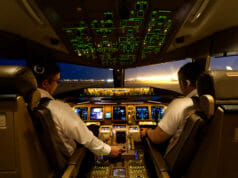
It was a clear day with light winds on 4 April 2018 when at 0953, a Piper Arrow came to rest in a field about two statute miles southwest of the airport where it had just performed a touch and go. Climbing through 900 feet in the calm crisp air; the pilot, who was on his commercial check ride, requested a turn to the crosswind leg. Unable to clear him for the turn, ATC advised the pilot to remain on the upwind leg, and moments later the airplane disappeared from radar.
The initial investigation revealed, and eye witness testimony confirmed, that the left wing separated from the airplane, resulting in an unrecoverable and fatal dive that killed both the student and the Designated Pilot Examiner on board.
Initial examination revealed that the controls still attached to the airplane were operable and connected, the left wing flap remained attached and movable and the control cables attached to the airplane wing had suffered tensile failure, when they were pulled beyond their strength limit as the wing departed the fuselage.
Further examination of the wreckage revealed that over 80% of the wing spar cap and wing spar doublers exhibited signs of metal fatigue and cyclical loading. The area immediately outboard of the 18 wing spar attachment bolts failed as a result of this fatigue, resulting in catastrophic separation of the wing from the rest of the aircraft.

This presents a point that, at some point in their flying career, every single pilot has wondered as they strap themselves into an airplane – Is this thing going to stay together for me? Fortunately, the normal and resoundingly common answer is, “Yes.” However, as the example above illustrates, there are still those cases where it does not hold true. Given the operational realities of the school where the plane was operated, both the 200 student and the 27,600 hour DPE had every reasonable expectation that the flight would go as intended. In addition to excellent maintenance, the school is known for strict standards and superior safety oversight.
So how does a situation like this slip through the cracks? How can a modern safety system, effective safety culture with good oversight, good feedback and excellent maintenance not catch such a major structural issue?
That is a question that will have to remain for the release of the NTSB’s final report, but it does highlight some pretty basic concepts we have previously touched on in this column. It feels like it has been beaten to death, but the absolute paramount importance of pilot reporting simply can’t be overstated.
One of the initial things that the investigation revealed was that the remaining portion of the lower wing spar cap exhibited signs of overstress. The cause of the overstress is unknown and may never be known, but for the purpose of this column, it is important to understand that metal fatigue requires two things. The first of these is a “stress riser” which could be a fault in the metal casting (as was the case with the engine blade failure that caused United’s Flight 232 accident in Sioux City, Iowa in 1991), or a pilot induced overstress crack or deformation such as pulling too many G’s during a maneuver or having a hard landing. The second component is “cyclical loading,” which essentially means that every time that part is subjected to stress AFTER the initial stress riser, it gets weaker and weaker, until it eventually fails. Depending on the nature of the original riser, the part, the strength and the amount of stress, failure can occur anywhere from several legs after damage to several years or decades after damage. In the case of United 232, the catastrophic failure was the result of a manufacturing defect several decades prior. In the case of a significant maneuvering overstress, failure may occur immediately; but the factors are always the same.
A common aviation saying is “there are those who have and those who will.” Every pilot has that approach that they just think is going to work out, and it doesn’t. Maybe the speed was a little bit low, maybe the focus was on the wrong viewpoint, maybe something environmental resulted in a last-minute change that couldn’t be fixed. Hard landings are inevitable, and they are magnified in a training environment where learning is occurring and risks for such an occurrence are higher.
However, operations at higher levels of experience can also put the same factors in play that result in an unintended hard landing. Fatigue, weather, high winds, inexperience in an airplane type, short runways and swept wings that are less forgiving of error can all contribute to hard landings, even at the airline level and even for people who have been doing it for decades and tens of thousands of hours.
However, the common link between all pilot induced maneuvers is the ability to say, “Hey, that really should be written up and checked out.” There is always an element of ego involved as pilots are typically result driven and pride themselves greatly on their performance, which can intentionally result in an unwillingness to report such an event. It is also possible that the pilot didn’t have an ego issue at all, and simply wasn’t sure if the landing was hard enough to warrant damage, or if it was within acceptable limits. Same with a maneuvering overstress. Few pilots are good at determining a maximum structure limit strictly from the seat of the pants, so they may not write it up due to uncertainty. A good test is that if you aren’t 100% comfortable with it, then it needs to be written up. There shouldn’t be much ambiguity on the matter, as it helps reduce those instances where we aren’t sure.
However, the rule is always “when in doubt, write it up.” It is always better to spend a little bit of time and cost to have maintenance look it over and determine that there is no damage, versus not having it examined and having the airframe or part fail later. The real irony of this specific issue is that it is usually not the offending pilot or crew that pays the price for the oversight or absence of a writeup.
To the instructor cadre out there, one of the most effective things you can teach your students is the importance of writing things up that may not otherwise be observed or detected, such as a hard landing. As a long-time instructor, it was not uncommon to write up a hard landing at least once a month due to the students’ learning curve. It was a small price to pay overall – to know that if my peers were doing the same, I was going to get a safe airplane on my next flight, and my friends were going to get one on theirs.
A person much wiser than I once said, “Being a professional means doing the right thing, even when no one is watching.” It is incumbent upon us, as aviators, to do our part in keeping our fellow aviators, their passengers and their families safe. Don’t be afraid to write issues up and don’t accept any pressure to do anything else. Your life or the life of a friend or colleague may very well depend on it.

























































































































